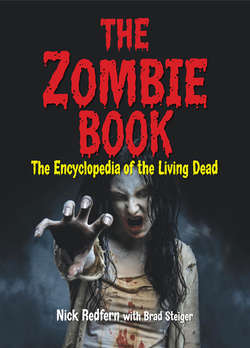Читать книгу The Zombie Book - Nick Redfern - Страница 60
The Crazies
ОглавлениеWhen you think of George A. Romero, several things immediately, and inevitably, spring to mind: death, chaos, a deadly virus, societal collapse, people running for their lives, and—last, but most assuredly not least—zombies. Well, in Romero’s 1973 film, The Crazies, you have all of those ingredients, except for one: the shambling dead. A Romero film, but one specifically without walking corpses: can it be true? Yes, it is true. But, instead of the dead, the cast of The Crazies are forced to do battle with something just as fearsome; hordes of living people who have been driven to homicidal levels of madness after being exposed to a military-created biological weapon.
Like most of Romero’s zombie movies, The Crazies—also released under the far less fearsome title of Code Name: Trixie—makes the viewer ponder deeply on how fragile society really is, and the speed with which it can fragment and collapse when death, disaster, and terror become overwhelming. It’s also a film from which the production teams of the likes of 28 Days Later and 28 Weeks Later likely took a great deal of inspiration.
The scary humans in 1973’s The Crazies are not zombified undead, but rather people ill with a disease that turns them into homicidal maniacs.
Evans City, Pennsylvania is where all of the carnage and homicidal behavior occurs. As it does so, we follow the plight of a trio of people trying to comprehend, and survive, the anarchy exploding all around them. They are David and Judy—a fireman and a nurse who also happen to be boyfriend and girlfriend—and Clank, also a fireman. When violent behavior quickly turns Evans City into a living hell, a large military contingent quickly arrives to take control of the alarming situation. Each and every one of them is decked out in protective gear of the type generally seen in chemical- and biological-warfare outbreaks, and are led by a Major Ryder.
Taking control basically means killing anyone and everyone who is living—whether they are infected or not. So, as is often the case when Romero is behind the lens, the stars of The Crazies are not just in danger of losing their lives to those with the virus, but to their normal, fellow people, too. As the film progresses, the death rate rises, the deranged infected become even more deranged, two of the characters fail to survive the onslaught, and the military starts to lose control of the situation. Zombie fans that have not seen The Crazies will be satisfied by its bleak ending: the Army is forced to retreat from what is now, for all intents and purposes, a city transformed into an outdoor asylum. Word reaches Major Ryder that another city is showing signs of infection. The end is becoming ever more nigh.
The Crazies was not a big hit with cinema-goers in 1973 or, indeed, ever since. In fact, it wasn’t even a small hit. In short, it bombed, big time. It has, however, and quite rightly, become a cult-classic among those that have a love for the crazed, the infected, and Romero. It also inspired a remake, in 2010, starring Timothy Olyphant of such movies as Hitman and Live Free or Die Hard. The budget was a big one, and the profits were impressive. Audience reactions, however, were mixed. Even though Romero himself acted as the executive producer and the co-writer on the new incarnation, many preferred the 1973 original to the special-effects-driven version of nearly forty years later. In short, not everyone was, ahem, crazy about bringing back The Crazies.
